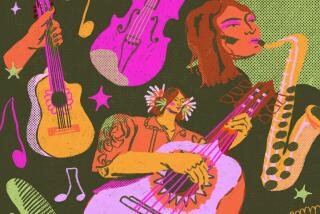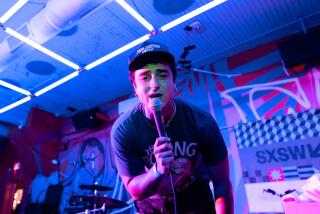FESTIVAL CELEBRATES REVIVAL OF GUITAR AS CLASSICAL INSTRUMENT
- Share via
EL CAJON — After nearly a century of proselytizing by Andres Segovia and a second generation of serious guitar virtuosos, the guitar’s reputation as a classical instrument has been rightfully restored.
Attaining academic respectability for the ubiquitous strummed instrument, however, has lagged behind the performers’ concert successes. Only in the past dozen years, for example, have music students at San Diego State University been allowed to major in guitar.
In recent semesters at Grossmont College here, both enrollment in guitar classes and the number of serious guitar course offerings have mushroomed. This weekend, the campus is awash in a guitar festival that features South American classical performance, a duo flamenco team, rare footage of Segovia’s Santiago de Compostela master classes, and seminars about a new, louder instrument called the bi-level guitar.
Guitarist Bartolome Diaz will bring the unique repertory of his native Venezuela to the festival in a solo recital tonight in the college’s Fine Arts Recital Hall. “The guitar is the Venezuelan national instrument,” Diaz said. The 30-year-old performer from Caracas was reached last week in San Francisco in the middle of his second North American tour.
“When I was touring in Belgium a few years back, I met a trio of Venezuelan musicians who were also on tour,” he recalled. “They asked me, ‘Why should you want to leave Venezuela? You already have the best possible audiences in Venezuela!’ ” Undaunted by the jocular advice of the fellow countrymen, Diaz made his London debut in 1983 and his New York City debut two years later.
He described the difference between the “handed-down” guitar traditions of South America and the scholarly traditions of European guitar performance.
“We have an unbroken tradition of guitar since the time of the Spaniards,” he said. “What came to Latin America was the Renaissance guitar, a small instrument with four double strings. It was more of a folk instrument and remains a South American folk instrument called the cuatro . A century later, the Baroque guitar came to South America, a five-string guitar called the cinco .”
European musical fashions changed, and these instruments fell out of favor. “Their performance practices were lost, so contemporary European guitarists had to go back to treatises to find out about the ways of guitar music between 1560 and 1694. But we never lost these instruments or their traditions,” Diaz said. He noted that, in Mexico, the Indians were not only taught how to play European music, but under the tutelage of the missionary friars, they became excellent organ builders and luthiers (guitar makers).
A protege of the late Venezuelan composer and guitarist Antonio Lauro, Diaz is devoting half of his Grossmont program to compositions by Lauro, including some of Lauro’s unpublished works never heard outside Venezuela. He will also play his own composition, “Retratos,” as well as pieces by Manuel Ponce and Francis Poulenc.
Saturday afternoon, guitarist David Marriott will demonstrate and explain the newly developed bi-level guitar. Designed by Roger Pytlewski and built by luthiers in La Jolla, this new guitar creates a louder sound for the performer who plays with orchestra or other ensembles. The instrument looks like a typical acoustic guitar with a slightly pregnant bulge at the lower end of the sound box.
According to Marriott, it sounds a little like a harp, from which the inventor borrowed certain principles of attaching the strings to the instrument’s frame. In spite of the advantages of a more robust sound, gaining a hearing for this new instrument has been slow, although Sharon Isben of the ensemble Guitarjam has commended the innovation.
“It’s not easy to change 200 years of history,” Marriott said. Traditionalists such as the Romeros, Del Mar’s internationally known family of guitar players, “are not excited about the bi-level guitar because we have done something to the Spanish guitar,” he said.
Flamenco performers Paco Sevilla and Rodrigo will close the Grossmont festival Saturday evening with a program of traditional and contemporary flamenco compositions sans dancers.
More to Read
The biggest entertainment stories
Get our big stories about Hollywood, film, television, music, arts, culture and more right in your inbox as soon as they publish.
You may occasionally receive promotional content from the Los Angeles Times.










